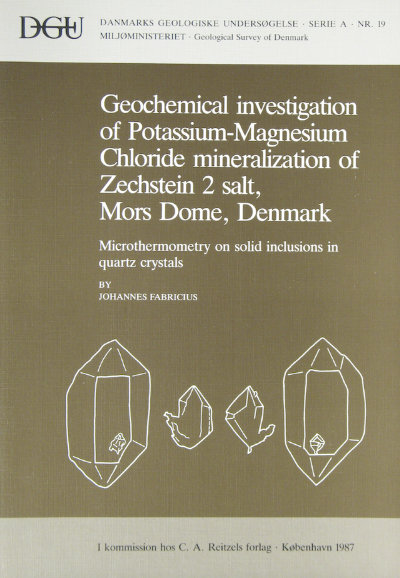Geochemical investigation of Potassium-Magnesium Chloride mineralization of Zechstein 2 salt, Mors Dome, Denmark
DOI:
https://doi.org/10.34194/seriea.v19.7038Keywords:
Quartz, Chemical composition, Carnallite, P, T conditions, Salt domesAbstract
Solid-rich inclusions at 20°C of the Na-K-Mg-Cl-H2O system, found in euhedral quartz from the top of Zechstein 2 salt in the Mors dome, Denmark, were objects of microthermometrical investigation. The quartz crystals, all of the long prismatic, slender type, average length of 750 μm, are genetically closely connected to the intercalated clay in the deck halite Na2r. The inclusions are faceted negative crystals, crystallographically orientated with the host quartz. Carnallite (KMgCl3 ·6H2O) is the main daughter mineral, followed by tetrahydrate (MgCl2-4H2O) and minor sylvite (KCl). Halite (NaCl) is found as grains in suspension in the trapped solutions. The trapped solutions represent melts of carnallite or tetrahydrate saturated with NaCl. The concentrations range from 167 mol MgCl2 + 83 mol K2Cl2 +3 mol Na2Cl2 per 1000 mol H2O to 250 mol MgCl2 + 5 mol K2Cl2 + 0 mol Na2Cl2 per 1000 mol H2O, corresponding to salinities from 52 to 62 weight%. Melting temperatures measured, 170-185°C, and estimated pressures, 80-110 MPa, are minimum trapping values. In a few cases highly irregular, "dry" grains of carnallite, containing dissolved high-pressure gas, were observed to have been trapped. In this study it is shown that the melting temperature of carnallite in a closed space, where evaporation is prevented, depends on the prevailing pressure. It is also shown that high-pressure gas is dissolved in trapped grains of carnallite or halite, but not in the solutions. Finally, the results lead to the proposal of a model, related to time and space, of the metamorphism of an original carnallitic potash bed and subsequent K-Mg-Cl mineralization of the deck halite. The original paragenesis kieserite-halite-carnallite, sedimented in the deeper parts of the basin, was altered to the present kieseritic hard salt by means of progressive geothermal metamorphism from Upper Triassic to Lower Cretaceous. The hanging wall of the potash bed, the deck halite, was mineralized by the metamorphic solutions, squeezed out from the potash bed, possibly during the diapiric penetration phase in Upper Jurassic - Lower Cretaceous.
Downloads
Published
Issue
Section
License
This article is distributed under a CC-BY 4.0 licence, permitting free redistribution and reproduction for any purpose, even commercial, provided proper citation of the original work. Author(s) retain copyright over the article contents.


